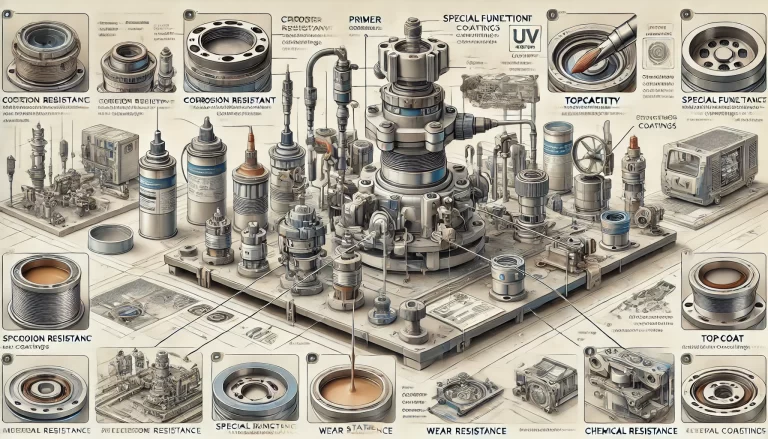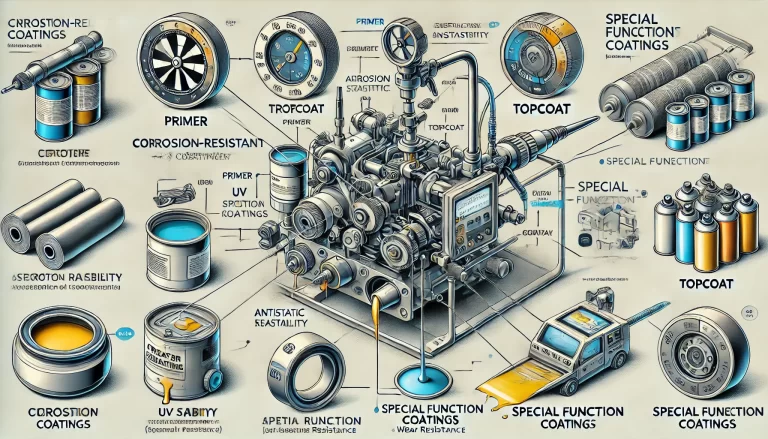In the production of instrumentation equipment, coating is not only used to enhance the appearance but also plays a crucial role in ensuring the long-term stable operation of the devices. Instrument enclosures and critical components are often exposed to various environmental conditions, meaning the choice of coating must meet multiple requirements, such as corrosion resistance, wear resistance, weather resistance, and chemical resistance. Additionally, the coating directly impacts the appearance, functionality, and service life of the equipment. Below, we will explore the primary functional requirements of coatings for instrumentation equipment and analyze the composition of these coatings.
1. Functional Requirements of Instrument Coatings
Instrumentation equipment is commonly exposed to industrial, chemical, or extreme environments, so the coating must possess several key functionalities:
Corrosion Resistance
Most instrumentation equipment is made of metal, which is susceptible to corrosion from moisture, salt spray, and chemicals. One of the primary tasks of the coating is to provide effective corrosion protection by preventing moisture and contaminants from penetrating the base material, thereby extending the equipment’s service life. Typically, epoxy resin coatings are used as primer layers due to their excellent resistance to moisture, oxidation, and chemical erosion.
Weather Resistance & UV Stability
For instruments used outdoors, coatings must resist the harmful effects of ultraviolet (UV) radiation. Prolonged exposure to sunlight can lead to fading, cracking, or degradation of the surface. Fluorocarbon coatings (PVDF) are commonly used in these cases as they offer strong UV resistance and high-temperature stability, ensuring long-lasting protection and maintaining aesthetic appeal.
Wear Resistance & Mechanical Strength
For instruments that require frequent handling, the coating’s wear resistance is essential. The coating must have sufficient hardness and toughness to withstand friction, impacts, and abrasions. Polyurethane topcoats, known for their excellent wear resistance and impact resistance, are commonly used on equipment surfaces that experience heavy use.
Chemical Resistance
Instrumentation equipment is often exposed to chemicals, especially in industrial settings. Therefore, the coating must resist corrosion from acids, alkalis, and other aggressive substances. Epoxy resin coatings, with their superior adhesion and resistance to chemicals, are often used to protect the surfaces of such devices.

2. Composition of Instrument Coatings
Depending on the functional requirements, coatings for instrumentation are usually composed of the following categories of components:
Primer
The primer is the base layer of the coating system, responsible for improving adhesion between the coating and the substrate, providing corrosion protection, and helping to fill in minor surface defects. Primer formulations typically contain epoxy resins, zinc powder, and zinc phosphate, which enhance adhesion and prevent oxidation of the substrate. Epoxy resin primers are widely used on metal surfaces because they create a strong bond with the metal and offer excellent corrosion protection.
Topcoat
The topcoat is the outermost layer, exposed to the external environment. It provides protection, improves appearance, and enhances durability. The topcoat must feature high hardness, UV resistance, and high-temperature tolerance. Polyurethane topcoats and acrylic topcoats are commonly used for instrument surfaces. These coatings offer strong UV protection, corrosion resistance, and scratch resistance while ensuring aesthetic appeal.
Special Function Coatings
For specific applications, instrument coatings may require additional functions:
- Antistatic Coatings: These are essential for electronic equipment to prevent static charge accumulation, which can damage sensitive components. These coatings often contain conductive fillers, such as carbon nanotubes or metal oxides.
- Antibacterial Coatings: Used in medical instruments or food processing equipment, these coatings help reduce bacterial growth. Common antibacterial agents include silver ions and copper ions.
3. Coating Thickness and Spraying Process Control
The thickness of the coating is crucial for its protective performance and visual appeal. A coating that is too thin may not provide the expected corrosion protection, while one that is too thick may peel, crack, or affect the appearance. Recommended coating thickness is typically determined by standards such as ISO 12944. For metal enclosures, the usual thickness ranges are:
- Primer Thickness: 20-50 μm. The primer layer should be slightly thicker to ensure the substrate receives adequate corrosion protection.
- Topcoat Thickness: 30-70 μm. The thickness of the topcoat is more flexible and can be adjusted based on the equipment’s required weather resistance, aesthetic needs, and environmental conditions.
- Total Coating Thickness: Typically ranges from 80-120 μm to provide long-lasting protection.
Key factors such as coating uniformity, drying time, and surface smoothness need to be strictly controlled, as they directly impact the coating’s protective properties and appearance.
4. Environmental Adaptability of Instrument Coatings
Instrumentation equipment often operates in diverse environments, so coatings must be selected for their adaptability to specific conditions. Depending on the application, factors such as UV resistance, chemical resistance, and mechanical strength should be considered when selecting coatings:
- Outdoor Instruments (e.g., traffic monitoring, meteorological equipment): Require high weather resistance and UV stability. Fluorocarbon coatings (PVDF) are recommended for these applications.
- Industrial Environment Instruments (e.g., chemical, petroleum equipment): Need coatings with chemical resistance and high-temperature tolerance. Epoxy resin coatings are ideal for these conditions.
- Medical Instruments (e.g., surgical devices, laboratory instruments): Must have antibacterial properties and be resistant to fingerprints. Coatings containing silver ions are commonly used.
- Electronic Instruments (e.g., power and telecommunication equipment): Require antistatic coatings to prevent static accumulation and potential damage to sensitive components.

5. Standards and Quality Testing
To ensure the quality of the instrument coatings, adherence to relevant industry standards is crucial. For example, ISO 12944 and other international standards provide detailed requirements for coating thickness, adhesion, corrosion resistance, and UV performance. In practical applications, the quality of the coating should be verified through standardized testing methods to ensure that the coating meets the required protection criteria for long-term use.
6. Conclusion
Selecting the right coatings for instrumentation equipment involves more than just enhancing appearance—it’s about meeting a wide range of protective performance requirements. By choosing appropriate combinations of primers and topcoats, controlling coating thickness, and ensuring the coating provides corrosion resistance, weather resistance, wear resistance, and chemical resistance, equipment manufacturers can guarantee the long-term stable operation of their products across various environments. By following international standards and choosing coatings suitable for each application, the performance and lifespan of instrumentation equipment can be significantly improved.
